Front/Rear Heated Seat Inoperative/Cold (Install Seat Heat Element)

| Subject: | Front/Rear Heated Seat Inoperative/Cold (Install Seat Heat Element) |
| Models: | 2000-2003 Cadillac DeVille (All Models) with RPO KA1 |
This bulletin is being revised to update the model year information. Please discard Corporate Bulletin Number 01-08-50-001B (Section 08-Body and Accessories)
Condition
Some customers may comment that the front/rear seat assembly heat function is not operating properly. The front/rear seat back and seat cushion remain cold when either the HEAT/OFF switch or the BACK ONLY switch is activated.
Cause
This condition may be due to a non-functioning heat element in the front/rear heated seat back/cushion trim cover.
The heated seat system consists of four heated seats, two in the front and two in the rear. On the DHS and DTS models, each heated seat consists of four heat elements, one in the seat back and three in the seat cushion. On the DeVille model, each heated seat consists of two heat elements, one in the seat back and one in the seat cushion.
DHS & DTS Seat Heat Element Locations
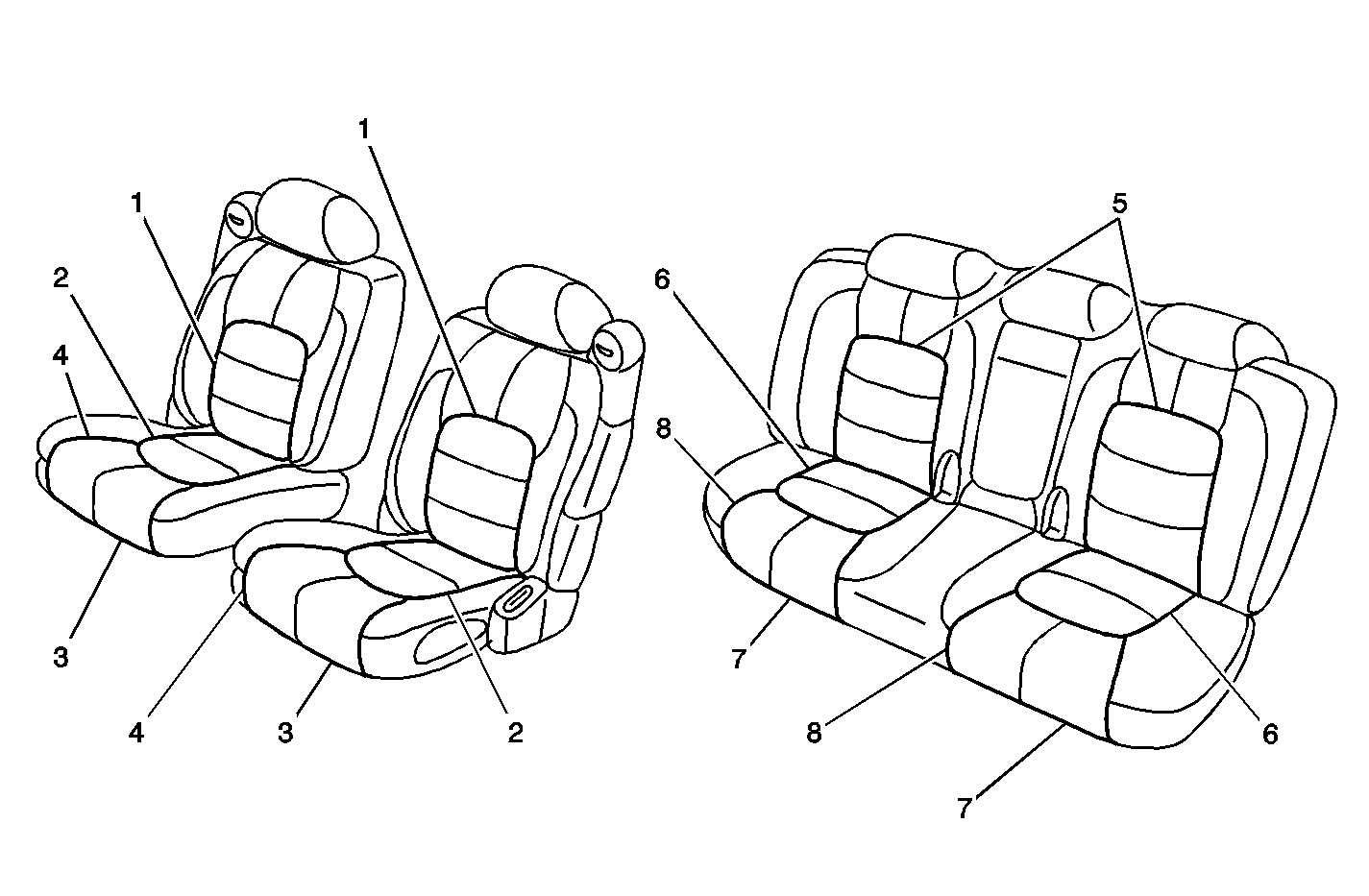
Location # | Part Number | Description |
|---|---|---|
1 | 25715920 | Front Seat Back Cushion Heat Element |
2 | 25715921 | Front Seat Cushion Heat Element |
3 | 25715924 | Front Seat Cushion (LH Thigh) Heat Element |
4 | 25715925 | Front Seat Cushion (RH Thigh) Heat Element |
5 | 25715926 | Rear Seat Back Cushion Heat Element |
6 | 25715927 | Rear Seat Cushion Heat Element |
7 | 25715928 | Rear Seat Cushion (LH Thigh) Heat Element |
8 | 25715929 | Rear Seat Cushion (RH Thigh) Heat Element |
DeVille Seat Heat Element Locations
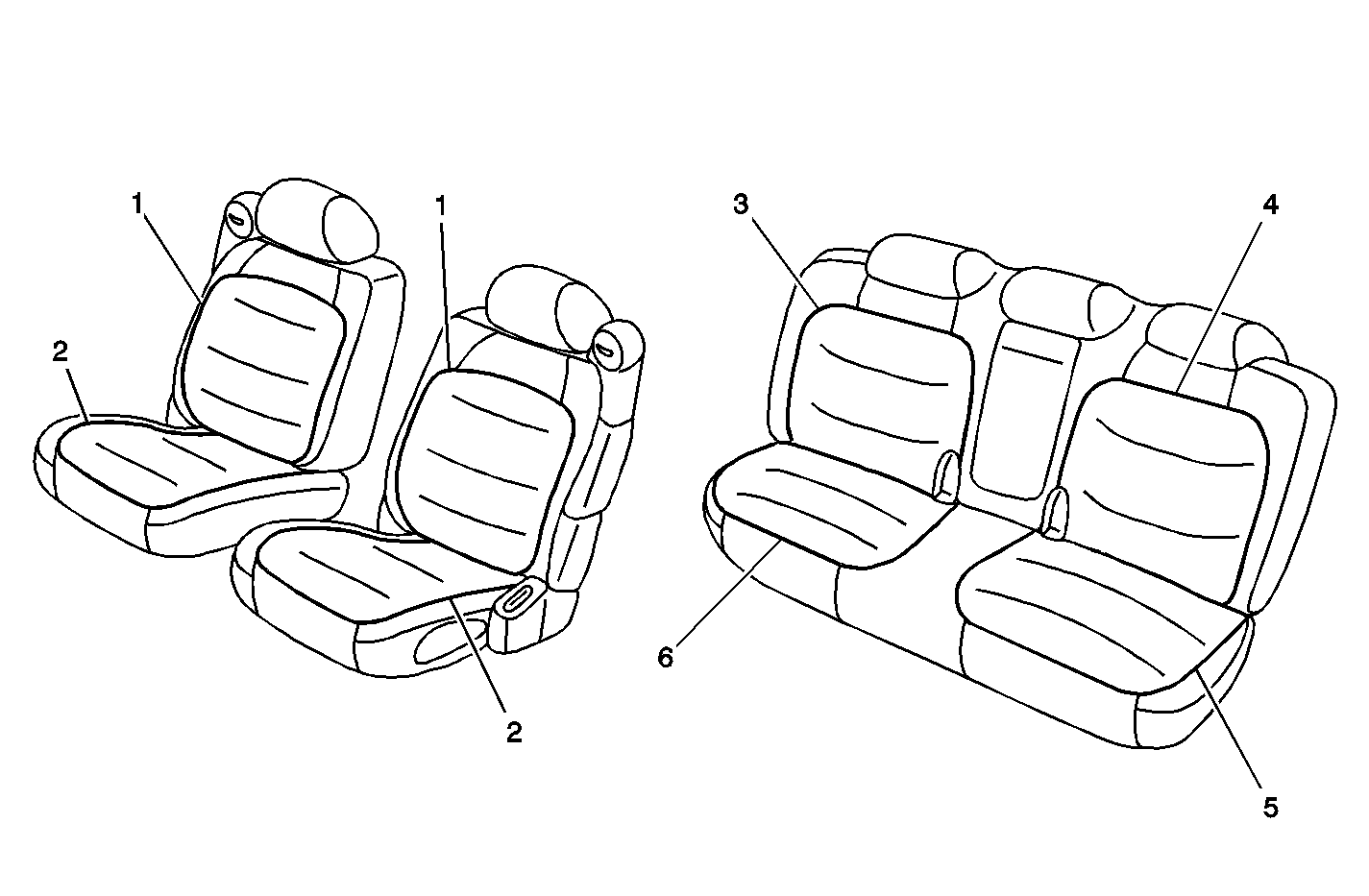
Location # | Part Number | Description |
|---|---|---|
1 | 25740850 | Front Seat Back Cushion Heat Element |
2 | 25740851 | Front Seat Cushion Heat Element |
3 | 25740853 | RH Rear Seat Back Cushion Heat Element |
4 | 25740852 | LH Rear Seat Back Cushion Heat Element |
5 | 25740854 | LH Rear Seat Cushion Heat Element |
6 | 25740855 | RH Rear Seat Cushion Heat Element |
Correction
- Determine which heat element is not functioning properly by measuring the resistance values of the factory heat elements. Refer to the appropriate diagnostic procedure in this bulletin.
- If the resistance values of a factory heat element are NOT within the specified range, install a service heat element between the non-functioning factory heat element and the seat trim cover. Refer to the Service Heat Element Installation Procedure in this bulletin.
DHS/DTS Front Seat Diagnostic Procedure
- Adjust the front seat assembly to the maximum up and rearward position in order to access the seat cushion fasteners.
- Remove the fasteners (1) retaining the seat cushion to the seat adjuster.
- Disconnect the heated seat module harness blue, 8-way connector C2 (2).
- Measure the front seat back element resistance between cavities G and H. Does the resistance measure less than 10 ohms?
- Measure the front seat back thermistor resistance between cavities E and F. Does the resistance measure between 280 ohms and 300 K ohms?
- Measure the front seat cushion thermistor resistance between cavities C and D. Does the resistance measure between 280 ohms and 300 K ohms?
- Measure the front seat cushion element resistance between cavities A and B. Does the resistance measure less than 10 ohms?
- Remove the front seat assembly from the vehicle. Refer to Seat Replacement in the Seats sub-section of the Service Manual.
- Remove the trim cover from the front seat cushion. Refer to Seat Cushion Cover Replacement -- Front in the Seats sub-section of the Service Manual.
- Disconnect the green 2-way connectors between the seat cushion center heat element and the seat cushion thigh heat elements.
- Measure the LH seat cushion thigh heat element resistance between cavities A and B at the green 2-way connector. Does the resistance measure less than 23 ohms?
- Measure the RH seat cushion thigh heat element resistance between cavities A and B at the green 2-way connector. Does the resistance measure less than 23 ohms?
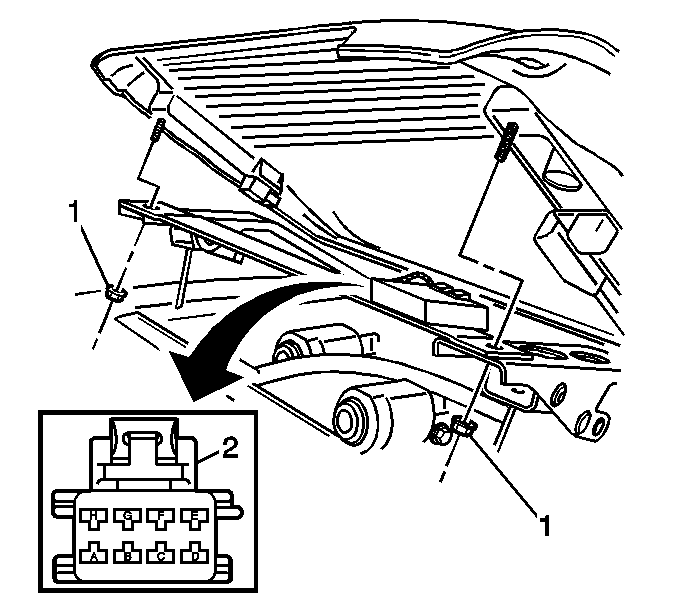
| • | If yes, go to Step 5. |
| • | If no, install a front seat back heat element. Refer to the Service Heat Element Installation Procedure in this bulletin. |
Important: If the resistance is measured with the seat still warm, the resistance may vary outside of the specified range since the thermistor resistance varies with temperature.
| • | If yes, go to Step 6. |
| • | If no, install a front seat back heat element. Refer to the Service Heat Element Installation Procedure in this bulletin. |
| • | If yes, go to Step 7. |
| • | If no, install a front seat cushion (center) heat element. Refer to the Service Heat Element Installation Procedure in this bulletin. |
| • | If yes, the resistance values of the front seat heat elements are within the specified range. To find the cause of the inoperative/cold heated seat, perform the standard diagnostic procedures in the Service Manual. |
| • | If no, go to Step 8 in order to determine which of the three seat cushion heat elements has a resistance value NOT within the specified range. |
| • | If yes, go to Step 12. |
| • | If no, install a front seat cushion LH thigh heat element. Refer to the Service Heat Element Installation Procedure in this bulletin. |
| • | If yes, install a front seat cushion (center) heat element. Refer to the Service Heat Element Installation Procedure in this bulletin. |
| • | If no, install a front seat cushion RH thigh heat element. Refer to the Service Heat Element Installation Procedure in this bulletin. |
DeVille Front Seat Diagnostic Procedure
- Adjust the front seat assembly to the maximum up and rearward position in order to access the seat cushion fasteners.
- Remove the fasteners (1) retaining the seat cushion to the seat adjuster.
- Disconnect the heated seat module harness blue, 8-way connector C2 (2).
- Measure the front seat back element resistance between cavities G and H. Does the resistance measure less than 10 ohms?
- Measure the front seat back thermistor resistance between cavities E and F. Does the resistance measure between 280 ohms and 300 K ohms?
- Measure the front seat cushion thermistor resistance between cavities C and D. Does the resistance measure between 280 ohms and 300 K ohms?
- Measure the front seat cushion element resistance between cavities A and B. Does the resistance measure less than 10 ohms?

| • | If yes, go to Step 5. |
| • | If no, install a front seat back heat element. Refer to the Service Heat Element Installation Procedure in this bulletin. |
Important: If the resistance is measured with the seat still warm, the resistance may vary outside of the specified range since the thermistor resistance varies with temperature.
| • | If yes, go to Step 6. |
| • | If no, install a front seat back heat element. Refer to the Service Heat Element Installation Procedure in this bulletin. |
| • | If yes, go to Step 7. |
| • | If no, install a front seat cushion heat element. Refer to the Service Heat Element Installation Procedure in this bulletin. |
| • | If yes, the resistance values of the front seat heat elements are within the specified range. To find the cause of the inoperative/cold heated seat, perform the standard diagnostic procedures in the Service Manual. |
| • | If no, install a front seat cushion heat element. Refer to the Service Heat Element Installation Procedure in this bulletin. |
DHS/DTS & DeVille Rear Seat Diagnostic Procedure
- Remove the rear seat cushion assembly (1) from the vehicle. Refer to Seat Cushion Replacement-Rear in the Seats sub-section of the Service Manual.
- At the rear seat cushion blue, 8-way connector C320 (2), measure the thermistor resistance.
- At the rear seat cushion blue, 8-way connector C320 (2), measure the element resistance.
- For DHS & DTS models ONLY: Remove the trim cover from the rear seat cushion. Refer to Seat Cushion Cover Replacement-Rear in the Seats sub-section of the Service Manual.
- For DHS & DTS models ONLY: At the LH/RH rear seat cushion, disconnect the green 2-way connectors between the seat cushion center heat element and the seat cushion thigh heat elements.
- For DHS & DTS models ONLY: Measure the LH seat cushion thigh heat element resistance between cavities A and B at the green 2-way connector. Does the resistance measure less than 30 ohms?
- For DHS & DTS models ONLY: Measure the RH seat cushion thigh heat element resistance between cavities A and B at the green 2-way connector. Does the resistance measure less than 30 ohms?
- Remove the rear seat back assembly from the vehicle. Refer to Seat Back Replacement-Rear in the Seats sub-section of the Service Manual.
- At the rear seat back LH (1) or RH (2) heated seat module, disconnect the blue, 8-way connector C2.
- Measure the rear seat back thermistor resistance between cavities E and F. Does the resistance measure between 280 ohms and 300 K ohms?
- Measure the rear seat back element resistance between cavities G and H. Does the resistance measure less than 10 ohms?
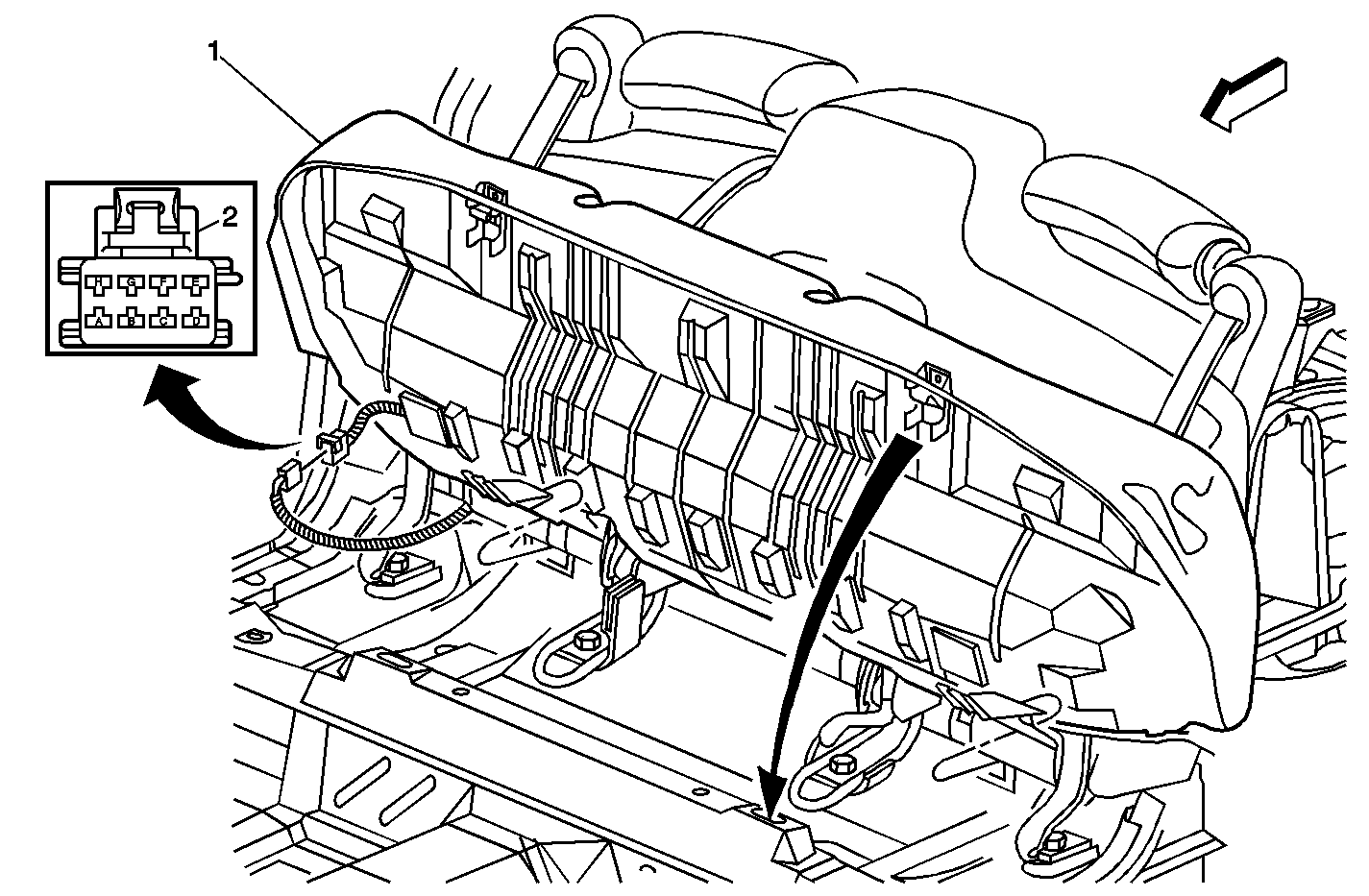
Important: If the resistance is measured with the seat still warm, the resistance may vary outside of the specified range since the thermistor resistance varies with temperature.
| • | For the LH rear seat cushion, measure between cavities C and D. Does the resistance measure between 280 ohms and 300 K ohms? |
| • | For the RH rear seat cushion, measure between cavities G and H. Does the resistance measure between 280 ohms and 300 K ohms? |
| • | If yes, go to Step 3. |
| • | If no, install a rear seat cushion (center) heat element. Refer to the Service Heat Element Installation Procedure in this bulletin. |
| • | For the LH rear seat cushion, measure between cavities A and B. Does the resistance measure less than 10 ohms? |
| • | For the RH rear seat cushion, measure between cavities E and F. Does the resistance measure less than 10 ohms? |
| • | If yes, go to Step 8. |
| • | If no, for DeVille models ONLY, install a rear seat cushion heat element. Refer to the Service Heat Element Installation Procedure in this bulletin. |
| • | If no, for DHS & DTS models ONLY, go to Step 4 in order to determine which of the three rear seat cushion heat elements has a resistance value NOT within the specified range. |
| • | If yes, go to Step 7. |
| • | If no, install a rear seat cushion LH thigh heat element. Refer to the Service Heat Element Installation Procedure in this bulletin. |
| • | If yes, install a rear seat cushion (center) heat element. Refer to the Service Heat Element Installation Procedure in this bulletin. |
| • | If no, install a rear seat cushion RH thigh heat element. Refer to the Service Heat Element Installation Procedure in this bulletin. |
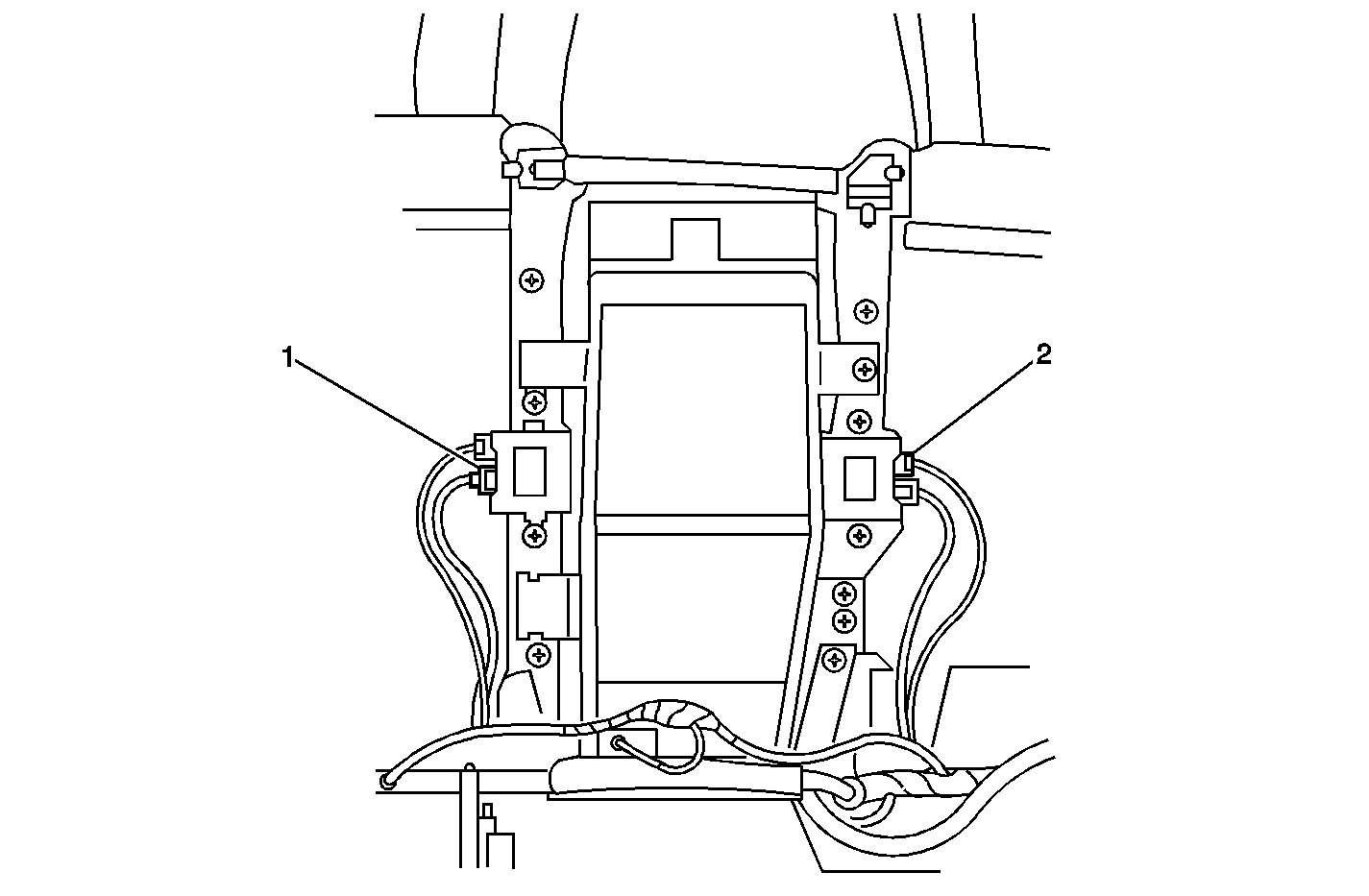
Important: If the resistance is measured with the seat still warm, the resistance may vary outside of the specified range since the thermistor resistance varies with temperature.
| • | If yes, go to Step 11. |
| • | If no, install a rear seat back heat element. Refer to the Service Heat Element Installation Procedure in this bulletin. |
| • | If yes, the resistance values of the rear seat heat elements are within the specified range. To find the cause of the inoperative/cold heated seat, perform the standard diagnostic procedures in the Service Manual. |
| • | If no, install a rear seat back heat element. Refer to the Service Heat Element Installation Procedure in this bulletin. |
Service Heat Element Installation Procedure
If a sublet trim repair facility is used, please provide a copy of this bulletin to the repair shop.
Important: Before installing the service heat element to the seat trim cover, verify that the resistance values are within the correct range. Refer to the following table.
Model | Range | Description |
|---|---|---|
ALL | Less than 10 ohms | Seat Back Elements |
DeVille (Base) | Less than 10 ohms | Seat Cushion Elements |
DHS & DTS | Less than 10 ohms | With Seat Cushion, LH & RH Thigh Elements Connected |
DHS & DTS | Less than 30 ohms | Seat Cushion Thigh Elements |
Important: DO NOT attempt to remove the factory heat elements from the seat trim cover. The service heat element is to be installed between the factory heat element and the seat trim cover.
- Remove the trim cover with the non-functioning heat element. Refer to the appropriate seat trim cover removal procedure in the Seats sub-section of the Service Manual.
- Place the seat trim cover on a clean flat surface with the inside facing out.
DHS/DTS and DeVille F/Seat (R/Seat Similar)
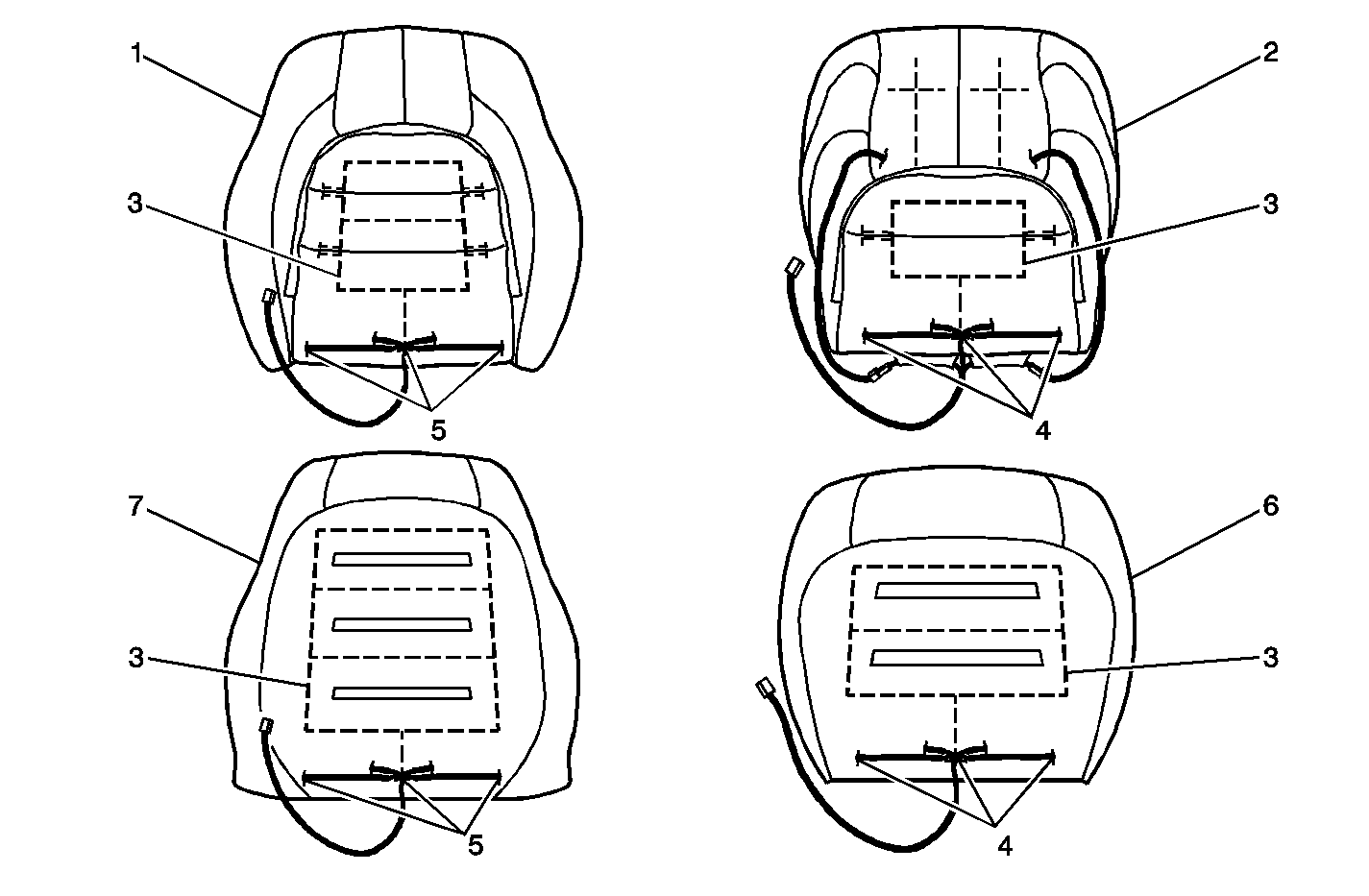
Parts Information
Model | Part Number | Description |
|---|---|---|
FRONT | ||
DeVille | 25740850 | F/Seat Back Cushion Heater |
DHS & DTS | 25715920 | |
DeVille | 25740851 | F/Seat Cushion Heater |
DHS & DTS | 25715921 | |
DHS & DTS | 25715924 | F/Seat Cushion (LH Thigh) Heater |
DHS & DTS | 25715925 | F/Seat Cushion (RH Thigh) Heater |
REAR | ||
DeVille LH | 25740852 | R/Seat Back Cushion Heater |
DeVille RH | 25740853 | |
DHS & DTS | 25715926 | |
DeVille LH | 25740854 | R/Seat Cushion Heater |
DeVille RH | 25740855 | |
DHS & DTS | 25715927 | |
DHS & DTS | 25715928 | R/Seat Cushion (LH Thigh) Heater |
DHS & DTS | 25715929 | R/Seat Cushion (RH Thigh) Heater |
Parts are currently available from GMSPO.
Warranty Information
For vehicles repaired under warranty, use:
Labor Operation | Description | Labor Time |
|---|---|---|
C7340* | RH F/Seat Cushion Heated Seat Component Heating Element-Replace | 1.1 hr |
ADD | Diagnosis Time | 0.0-0.3 hr |
C7341* | RH F/Seat Back Heated Seat Component Heating Element-Replace | 1.5 hr |
ADD | Diagnosis Time | 0.0-0.3 hr |
C7342* | LH F/Seat Cushion Heated Seat Component Heating Element-Replace | 1.1 hr |
ADD | Diagnosis Time | 0.0-0.3 hr |
C7343* | LH F/Seat Back Heated Seat Component Heating Element-Replace | 1.5 hr |
ADD | Diagnosis Time | 0.0-0.3 hr |
C7344* | RH R/Seat Cushion Heated Seat Component Heating Element-Replace | 0.9 hr |
ADD | Diagnosis Time | 0.0-0.3 hr |
C7345* | RH R/Seat Back Heated Seat Component Heating Element-Replace | 1.0 hr |
ADD | Diagnosis Time | 0.0-0.3 hr |
C7346* | LH R/Seat Cushion Heated Seat Component Heating Element-Replace | 0.9 hr |
ADD | Diagnosis Time | 0.0-0.3 hr |
C7347* | LH R/Seat Back Heated Seat Component Heating Element-Replace | 1.0 hr |
ADD | Diagnosis Time | 0.0-0.3 hr |
*This labor operation is new and will be included in the next update of the Labor Time Guide. | ||
